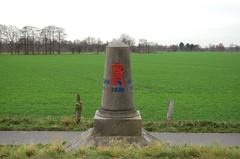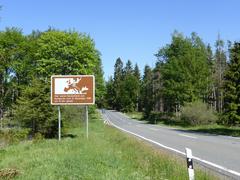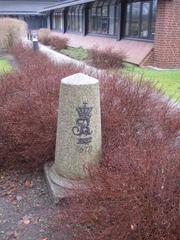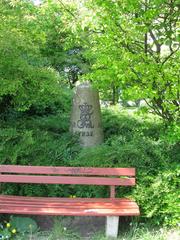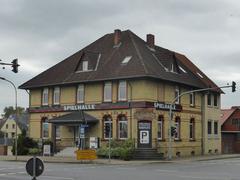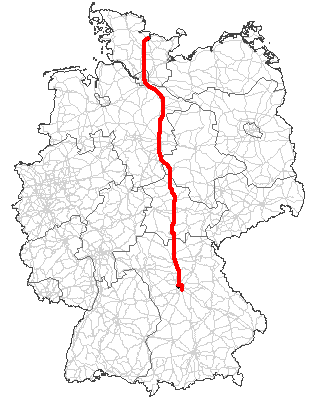
Bundesstraße 4 Hamburg: Visiting Hours, Tickets, and Historical Sites Guide
Date: 14/06/2025
Introduction: Discovering Bundesstraße 4 in Hamburg
Bundesstraße 4 (B4) in Hamburg is not just a federal highway—it’s a living corridor that has shaped and reflected the city’s evolution for centuries. Running from Hamburg northwards toward the Czech border, the B4’s Hamburg section weaves through neighborhoods rich in architectural heritage, educational prominence, and vibrant community life. Once a medieval salt and trade route, today the B4 connects visitors to a diverse array of landmarks, from historical churches and museums to bustling markets and entertainment districts.
This comprehensive guide explores the B4’s historical development, cultural significance, and practical visitor information. Whether you are a history enthusiast, architecture lover, or traveler seeking to experience Hamburg’s urban spirit, Bundesstraße 4 offers an enriching journey through the heart of the city (onlinestreet.de, hamburg.com, bussgeldkatalog.org, thesavvybackpacker.com).
Contents
- Early Development and Naming of Bundesstraße 4
- Historical Significance in Hamburg’s Urban Fabric
- Architectural and Social Landscape
- Key Historical Periods: WWII and Modernization
- Bundesstraße 4 in Hamburg’s Transportation Network
- Visitor Information: Accessibility, Visiting Hours & Tips
- Major Attractions and Landmarks Along the B4
- Culture, Community, and Modern Challenges
- FAQs
- Conclusion & Further Resources
Early Development and Naming of Bundesstraße 4
The B4 is one of Germany’s oldest federal roads, with its Hamburg section rooted in medieval trade as part of the historic “Salzstraße” (Salt Road). The route was formalized in the 19th and early 20th centuries, aligning with Hamburg’s growth as a Hanseatic trading center. The local term “Bundesstraße” underscores its significance in the national network, and its alignment through districts like Rotherbaum and Eimsbüttel illustrates its integration into the city’s daily life (onlinestreet.de).
Historical Significance in Hamburg’s Urban Fabric
The B4’s trajectory through Hamburg is a lens into the city’s transformation—from a Hanseatic port to a modern metropolis. In the Rotherbaum district and beyond, the B4 became a central axis for residential, educational, and commercial development during the late 19th and early 20th centuries. Today, it remains a crucial connector, linking diverse communities and facilitating both local and through traffic (hamburg.com).
Architectural and Social Landscape
Bundesstraße 4 showcases Hamburg’s architectural evolution, with Wilhelminian-era facades, post-war reconstructions, and modern developments standing side by side. Notable are the 42 historically recognized buildings between house numbers 3 and 55, representing a cross-section of the city’s urban heritage (onlinestreet.de). The area’s social fabric is equally vibrant, with a mix of long-term residents, students, and professionals contributing to a cosmopolitan atmosphere.
Key Historical Periods: WWII and Modernization
World War II and Post-War Reconstruction
The B4 area in Hamburg experienced damage during WWII but preserved much of its pre-war urban character. Post-war efforts focused on restoring functionality and improving infrastructure, including the addition of modern road surfaces and lighting (onlinestreet.de).
Urban Renewal and Modernization
From the late 20th century onward, the B4 has adapted to increased traffic, with expanded lanes and dedicated cycling infrastructure reflecting Hamburg’s commitment to sustainable urban mobility (onlinestreet.de).
Bundesstraße 4 in Hamburg’s Transportation Network
The B4 remains a backbone of the city’s transportation system, linking the city center with outlying districts and facilitating access to major motorways (A7 and A1). Its integration with public transport—bus lines and stations such as Sternschanze—ensures high accessibility for all visitors (bussgeldkatalog.org). The corridor is well-equipped for pedestrians and cyclists, with wide sidewalks and dedicated bike lanes.
Visitor Information: Accessibility, Visiting Hours & Tips
- Accessibility: The B4 is a public street accessible at all times; there are no entry tickets or restricted visiting hours.
- Parking: Limited street parking is available; public transport or cycling is recommended for convenience.
- Best Time to Visit: Daytime hours are ideal for exploring shops, cafes, and cultural sites.
- Guided Tours: Local operators offer guided walking and cycling tours that include the Rotherbaum district and other B4 highlights.
- Safety: Observe speed limits (typically 50 km/h in urban areas) and be mindful of cyclists and pedestrians.
- Weather: Hamburg’s climate is mild but can be rainy—bring appropriate clothing.
Major Attractions and Landmarks Along the B4
Educational and Cultural Institutions
- University of Hamburg – Campus Bundesstraße: Home to several faculties, including Earth Sciences and the MIN-Forum. Visit University of Hamburg for details on public access.
- Emilie-Wüstenfeld-Gymnasium: A historic school located near the B4.
Museums and Art
- Hamburger Kunsthalle: One of Germany’s premier art museums, open Tuesday–Sunday 10:00–18:00; tickets €14 (concessions available). The Kunstmeile Card offers discounted combined entry to several museums.
- Speicherstadt and Kontorhausviertel (UNESCO World Heritage): Accessible from the B4, featuring museums like the Speicherstadtmuseum (10:00–18:00) and Miniatur Wunderland (official site).
Historic and Religious Sites
- St. Michael’s Church (“Michel”): Iconic baroque church, open daily 10:00–18:00; tower access €5. Guided tours available (official website).
- Hamburg City Hall (Rathaus): Guided tours Tuesday–Sunday, 10:00–16:00; tickets approx. €5 (Hamburg City Hall site).
Entertainment and Leisure
- Reeperbahn/St. Pauli: Hamburg’s famed nightlife district, with venues open from early evening until late.
- Landungsbrücken and Port of Hamburg: Departure point for harbor tours (ferry tickets at piers; harbor tours ~€15). The Old Elbe Tunnel is open daily, free entry.
- Fish Market (Fischmarkt): Lively market on Sundays, 5:00–9:30 AM, free entry.
Parks and Waterfronts
- Jungfernstieg and Alsterufer: Popular promenades for shopping and scenic walks; accessible by foot, bike, or public transport.
Culture, Community, and Modern Challenges
Bundesstraße 4 is a community anchor, especially in districts like Rotherbaum and Eimsbüttel, with amenities including bakeries, pharmacies, and sports clubs. Preservation efforts focus on maintaining historical character while enhancing pedestrian and cycling infrastructure, green spaces, and road safety (onlinestreet.de). Active community participation helps balance modern demands with heritage conservation.
Frequently Asked Questions (FAQs)
Q: How do I best reach Bundesstraße 4 in Hamburg?
A: Public transport is recommended; Sternschanze station is a convenient access point, and several bus lines serve the B4 corridor.
Q: Are there guided tours of Bundesstraße 4?
A: Yes, local operators offer walking and cycling tours that include the B4 and nearby historical districts.
Q: Are tickets or specific visiting hours required?
A: No tickets or set hours are needed for the B4 itself. Museums and attractions along the route may have their own hours and ticketing.
Q: What are the top attractions near Bundesstraße 4?
A: The University of Hamburg, Hamburger Kunsthalle, St. Michael’s Church, Speicherstadt, and the Reeperbahn are all accessible from the B4.
Q: Is the B4 accessible for visitors with mobility challenges?
A: Most major attractions along or near the B4 provide accessibility features; check individual sites before visiting.
Conclusion: Your Gateway to Hamburg’s History and Culture
Bundesstraße 4 is more than a thoroughfare—it’s a living, evolving corridor that connects Hamburg’s past and present. From academic hubs and museums to historic churches and vibrant markets, the B4 invites locals and visitors alike to explore Hamburg’s layered identity. Leverage public transport, guided tours, and digital tools like the Audiala app to enrich your visit and discover hidden gems along the way.
Further Resources and Official Links
- Exploring Bundesstraße 4 in Hamburg: History, Visitor Information & Nearby Attractions
- Hamburg Tourism Official Site
- Bundesstraße 4 Blitzer Information
- Hamburg Travel Guide by The Savvy Backpacker
- Hamburg Tourism Magazine
- Hamburg Digital Mobility Data
For additional maps, images, and interactive tools, visit Falk Routenplaner, Planroute.de, and official museum or city tourism websites.

